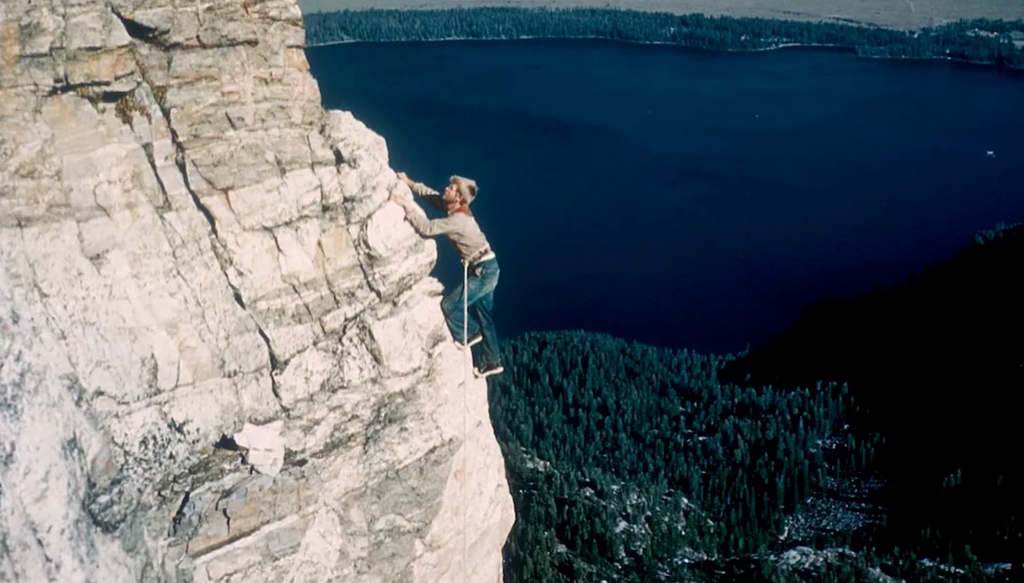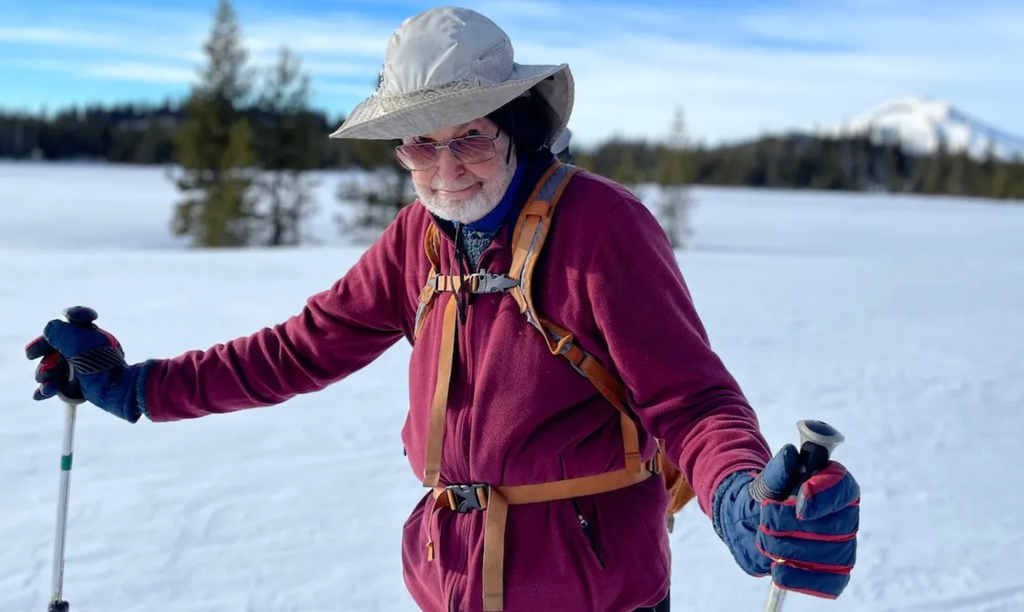Your cart is currently empty!
First Ascent, Second Tower, Last Man

John Mowat on Symmetry Spire’s Durrance Ridge with Jenny Lake below. Photo: George Mowat.
John Mowat remembers the day 71 years ago when he and three others became the first to climb the Grand Teton’s Second Tower, a pyramid on the mountain’s skyline that partially crumbled last fall.
He recalls how partner Leigh Ortenburger left his customary lunch of six peanut butter-and-jelly sandwiches behind. How Nick Clinch sustained Ortenburger with “pretty greasy” World War II canned military pemmican. And how Richard (Dick) Irvin pounded pitons fashioned by Yosemite climbing legend John Salathé into cracks in the rock.
The brash youngsters, all in their early 20s, were climbing the Grand’s East Ridge, a route that bypasses the Second Tower on the way to the 13,775-foot summit of the mountain. Of the 24 parties that had climbed the East Ridge by 1951, none had bothered to scale the Second Tower, a pyramid some 150 feet high that reaches a bit over 12,960 feet above sea level.
Claiming and documenting a first ascent, especially of landmarks like the Second Tower, offers adventure and even some measure of prestige, at least among “conquistadors of the useless,” as one alpinist called his fraternity. On July 18, 1951, the four men became the first to stand on the tower’s granite apex.
But spectacular rockfall last September sent more than 100 feet of the tower’s west side cascading to glaciers and snowfields below, forever changing the world-famous Teton skyline.
Seven decades also rasped the Second Tower’s fraternity of four.
“I am the only one alive from the first ascent,” Mowat observed after recently learning of the collapse.
Last man standing
“We grow old and die or things get eroded away or mountains fall down,” Mowat, who at 94 now lives in Bend, Oregon, said. “It would be sort of disappointing to see the whole entire Second Tower go away, but that’s just the way the universe works.”
In 1951 crumbling and decay might not have been forefront in the minds of the men as they passed the first tower, the Molar Tooth, and climbed on.
“It was not long before we hit the Second Tower,” Mowat said. They moved to the right following the normal bypass route.

John Mowat, Richard Irwin and Nick Clinch in 1951. Photo: George Mowat
“On the north side … there was a plentitude of ice — and it was really slick ice,” Mowat said. The mountain’s north side dropped away. “It was exposed,” he said of the airy perch.
Clinch described the moment of decision to scale the Second Tower many years later in the American Alpine Journal. Ortenburger was a fledgling climbing guide on a busman’s holiday — but hadn‘t yet climbed the route.
“We asked Leigh, our Teton guru, where the route went,” Clinch wrote. “‘The route goes up there,’ [Ortenburger] said, pointing to a difficult-looking chimney. ‘Dick, you lead.’”
Roped up and ready, Irvin drove pitons into a crack to aid him up. The rest of the boys followed, one by one. Regardless of what brief satisfaction there might have been atop the tower, serious business lay ahead.
“One of the more difficult problems of this [Second Tower] climb is getting off,” Ortenburger later wrote in his meticulous book A Climber’s Guide to the Teton Range. Getting off calls for “a spectacular double-rope rappel,” much of it while dangling away from an overhanging rock face.
Beyond that, the team met the East Face snowfield, which they booted up, ice axes in hand, before making the top of the Grand. The entire undertaking was somewhat perilous.
The East Ridge of the Grand was the site of a “spectacular tragedy” in 1934 when Fred Ohlendorff and Helmut Leese fell off, one on each side. Searchers found one body on the Teton Glacier, the other on Teepe Glacier — an ice mass whose name recalls Theodore Teepe who met his end there in 1925.
How many years?
A picture of Irvin, Clinch and Mowat from the day shows a rag-tag group of jean-clad, flannel-flanked bucks unknowingly headed for the pantheon of mountaineers. Their lifelong bonds grew in part from their association through the Stanford Alpine Club, Sierra Club and the American Alpine Club.
A Berkeley, California native, high school math teacher and family man, Irvin went on to pioneer routes around the world. “He was the mountaineering equivalent of Kilroy,” Clinch wrote in the AAJ. Mount Saint Elias, check. Canadian Rockies, check. Rakaposhi, Gasherbrum, Mount Cook, check, check, check.
“No matter where you went, he had been there first,” Clinch wrote. “Accounts of his climbs would fill an entire AAJ,” an annual that regularly exceeds 300 pages.
Ortenburger, a mathematician, statistician and father from Oklahoma and later Berkeley, pioneered climbs in the Andes, Tetons and Himalaya and co-wrote the 415-page Teton guidebook. No other name may be more closely associated with the lore of Wyoming’s most famous mountains than Ortenburger’s.
Clinch, a Bay-Area attorney and U.S. Air Force reserve major, organized a 1958 expedition to Gasherbrum in the Karakorum. It was the only time Americans made the first ascent of an 8,000-meter (26,246-foot) peak. He was also on the first ascent of Karakorum giant Masherbrum and first on Antarctica’s highest point, Mt. Vinson. In the Tetons he established the Grand Teton Climbers’ Ranch, a bunkhouse basecamp at the foot of the range that’s run by the American Alpine Club.
Mowat grew up in Hawaii, was a Stanford swimmer and earned a Ph. D. in physics before teaching at a number of universities. He pioneered routes in the Tetons and climbed throughout the Canadian Rockies. He is married to his second wife, Susan Sullivan, and has a daughter and a son. He skis both downhill and cross country and still climbs.
“I knew all of us had a passion for mountains,” Mowat said. “We loved it and enjoyed it.” But back in 1951, “I didn’t think we were anything special.”
All but Mowat are now gone.
The 1991 Oakland fire consumed Ortenburger, a loss akin to “the Second Tower and the Molar Tooth [falling] off the Grand Teton,” guidebook co-author Renny Jackson wrote in the book’s 1996 revision. Cancer took Irvin in 2001, after a long fight. Clinch died in 2016 of an incurable sarcoma.
The tower is half gone too.
“It’s in a fragile state,” Mowat said. “I wouldn’t be surprised if the rest of it fell down. That would be really ironic — to make the first ascent of something that doesn’t exist anymore.”
Washed to the sea
Mowat is a fan of geology, biology and the second law of thermodynamics — the inevitability of decay. “Countless mountain ranges have come and gone,” he said.
Even as parts erode, the young Teton Range is rising at perhaps an average of a millimeter a year. Meantime, the valley below, Jackson Hole, “contains more landslides and rock mudflows than almost any other part of the Rocky Mountain region,” David Love and John Reed Jr. wrote in Creation of the Teton Landscape.
Outlasting part of the Second Tower, “I don’t know whether that’s a point of satisfaction or not,” Mowat said.
How one measures oneself against a mountain, how one reckons with time, are matters of religion, Mowat said. A Zen Buddhist, he has confronted what might or might not be when the Second Tower’s last man, too, is no longer standing.
“You need to actually grapple with what you consider to be the worst possibility,” he said of the end. “Eternal non-being … eternal loss of awareness … awareness of the arts, of music, of geologic time spans … is to me the worst possibility.
“A religion has to cope with that,” he said. “I wouldn’t say I’m completely comfortable with the idea, but I’m becoming more and more reconciled to it.”
Outlasting part of the Second Tower may not be a point of satisfaction. But living a life in the mountains, where the uncertain outcome of each venture added spice, could be. Each of the four fell in love with the hills early.

John Mowat. Photo: Susan Sullivan
Clinch spent youthful summers at a camp in Estes Park, Colorado, where he became a junior counselor, along with Everest pioneer Tom Hornbein. Ortenburger “at an early age demonstrated an instinctive interest in climbing by falling out of a tree and breaking his arm,” Clinch joked in the obituary he wrote for the guidebook author and explorer. Irvin’s parents took him camping in the Sierra Nevada when he was 5 and he never looked back.
Mowat caught the bug at 7 years old in 1936 when his parents took him on a trip to Washington.
“As soon as I saw Mount Rainier, I became entranced by mountains,” he said. “I wanted to climb.”
When his family visited the Tetons in 1949, “that was the trigger for me.”
Mystery of the mountain
Despite the stellar résumés of the Second Tower’s first ascent party and members’ attention to detail and record keeping, an aspect of this history remains foggy. Did the four climb the Second Tower on purpose?
Did they climb the tower because they had no crampons to cross all the snow and ice on the normal bypass? Did the tower look easier than the alternative? Did they clamber to the summit because they were off route? Had Ortenburger “seized the opportunity to use Dick’s talents to make a first ascent,” as Clinch later wrote?
“Anyone’s memory of events is likely to be flawed,” Mowat wrote in an email. Clinch, for example, mentioned only five Ortenburger peanut butter-and-jelly sandwiches, not the six Mowat recalled.
“By the time I was brought up [to the base of the crux pitch], the determination to climb the tower had been made,” Mowat wrote.
“In those days Leigh did not have the exhaustive knowledge of the range he later acquired,” Mowat’s email reads. “So I doubt that he knew the Tower was unclimbed.
“I certainly assumed it had been climbed. I’m sure that Richard would have proposed the Tower climb, knowing he could likely lead it.
“We all knew that the usual route went up the icy part of the traverse around the tower and that chopping steps in the ice would be a chancy proposition,” Mowat went on. “I’m skeptical about Nick’s idea that Leigh deliberately misled us about the route since it was easier than the alternative.
“But I could be wrong,” Mowat wrote. “Your guess is as good as mine.”
Words by Angus M. Thuermer Jr. This piece was originally published at WyoFile.
GIVE YOURSELF THE GIFT OF ANALOG




